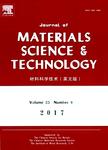Effect of Microstructure of Composite Powders on Microstructure and Properties of Microwave Sintered Alumina Matrix Ceramics
Effect of Microstructure of Composite Powders on Microstructure and Properties of Microwave Sintered Alumina Matrix Ceramics作者机构:Department of Materials ScienceHarbin Institute of Technology Tianjin Cement Industry Design & Research Institute Co.Ltd. School of Materials Science and EngineeringHebei University of Technology China Gas Turbine Establishment National Defense Science and Technology Key Lab for Reliability and Environment Engineering TechnologyBeijing Institute of Spacecraft Environment Engineering
出 版 物:《Journal of Materials Science & Technology》 (材料科学技术(英文版))
年 卷 期:2013年第29卷第5期
页 面:429-433页
核心收录:
学科分类:0806[工学-冶金工程] 0817[工学-化学工程与技术] 08[工学] 0805[工学-材料科学与工程(可授工学、理学学位)] 080601[工学-冶金物理化学] 0703[理学-化学] 0802[工学-机械工程] 0702[理学-物理学] 0801[工学-力学(可授工学、理学学位)]
基 金:supports of the National Natural Science Foundation of China(Grant No. 51102074) the Science Foundation of Postdoctor of China (Grant No.20110490979)
主 题:Al2O3 Composites Microwave processing Mechanical properties
摘 要:Two kinds of different structured alumina-titania composite powders were used to prepare alumina matrix ceramics by microwave sintering. One was powder mixture of alumina and titania at a micron-submicron level, in which fused-and-crushed alumina particles (micrometers) was clad with submicron-sized titania. The other was powder mixture of alumina and titania at nanometer-nanometer level, in which nano-sized alumina and nano-sized titania particles were homogeneously mixed by ball-milling and spray dried to prepare spherical alumina-titania composite powders. The effect of the microstructure of composite powders on microstructure and properties of microwave sintered alumina matrix ceramics were investigated. Nano-sized composite (NC) powder showed enhanced sintering behavior compared with micro-sized composite (MC) powders. The as- prepared NC ceramic had much denser, finer and more homogenous microstructure than MC ceramic. The mechanical properties of NC ceramic were significantly higher than that of MC ceramic, e.g. the flexural strength, Vickers hardness and fracture toughness of NC ceramic were 85.3%, 130.3% and 25.7% higher than that of MC ceramic, respectively. The improved mechanical properties of NC ceramic compared with that of MC ceramic were attributed to the enhanced densification and the finer and more homogeneous microstructure through the use of the nanostructured composite powders.



